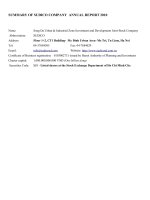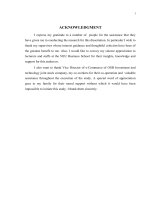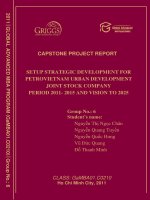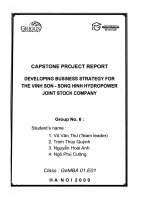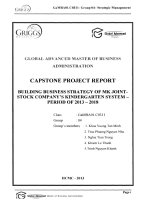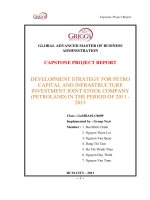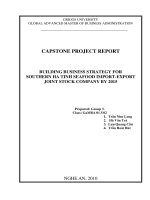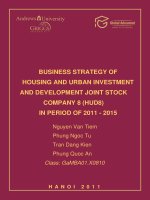Business strategy of housing and urban investment and development joint stock company 8 (hud8) in period of 2011 - 2015
Bạn đang xem bản rút gọn của tài liệu. Xem và tải ngay bản đầy đủ của tài liệu tại đây (1.14 MB, 77 trang )
GLOBAL ADVANCED MASTER OF BUSINESS ADMINISTRATION PROGRAM
MBA GRADUATION REPORT GROUP 12
1
BUSINESS STRATEGY OF
HOUSING AND URBAN INVESTMENT
AND DEVELOPMENT JOINT STOCK
COMPANY 8 (HUD8)
IN PERIOD OF 2011 - 2015
Nguyen Van Tiem
Phung Ngoc Tu
Tran Dang Kien
Phung Quoc An
Class: GaMBA01.X0810
H A N O I 2 0 1 1
GLOBAL ADVANCED MASTER OF BUSINESS ADMINISTRATION PROGRAM
MBA GRADUATION REPORT GROUP 12
2
GRIGGS UNIVERSITY
GLOBAL ADVANCED MASTER OF BUSINESS ADMINISTRATION
PROGRAM
BUSINESS STRATEGY OF
HOUSING AND URBAN INVESTMENT AND DEVELOPMENT JOINT
STOCK COMPANY 8 (HUD8)
IN PERIOD OF 2011 - 2015
Group Number: 12
Student‟s name: Nguyen Van Tiem
Phung Ngoc Tu
Tran Dang Kien
Phung Quoc An
HA NOI 2011
GLOBAL ADVANCED MASTER OF BUSINESS ADMINISTRATION PROGRAM
MBA GRADUATION REPORT GROUP 12
3
ACKNOWLEDGEMENT
We would like to thank guiding teachers who helped us to research the theory
and analyze business environment of Housing and Urban Investment and Development
Joint Stock Company 8 (HUD8) and give out business strategic methods. On the basis of
analyzing, we proposed the choice of business strategy for HUD8 in the next 5 years, our
group stated some solutions on both macroscopic and microcosmic aspects. The
solutions show necessary orientations that need to be changed and improved in order to
implement business strategy of the Company. However, due to the limited time and
qualification, this capstone project report can not avoid mistakes. We hope to receive the
contributions from teachers to improve the report.
We thank teachers for helping us to finish this report.
Hanoi, December 2011
GLOBAL ADVANCED MASTER OF BUSINESS ADMINISTRATION PROGRAM
MBA GRADUATION REPORT GROUP 12
4
TABLE OF CONTENTS
ACKNOWLEDGEMENT 3
TABLE OF CONTENTS 4
LIST OF TABLES 7
LIST OF FIGURES 8
INTRODUCTION 9
1. General environment, content of the report. 9
2. Researching objects and scale. 9
3. Researching method. 10
4. Layout of the thesis. 10
CHAPTER 1 11
BASIC THEORY ON CONSTRUCTING STRATEGY FOR ENTERPRISE 11
1. Mission and main targets. 11
2. Strategy constructing process. 11
3. Analyzing external environment. 12
3.1. Analyzing macroscopic environment. 12
3.2. Analyzing environment of business line 13
4. Analyzing environment inside the enterprise 16
4.1. Resource 16
4.2. Financial capacity 16
4.3. Enterprise administration 16
5. Selecting business strategy method. 16
5.1. SWOT matrix 16
5.2. Setting up QSPM matrix. 18
5.3. Selecting business strategy. 19
GLOBAL ADVANCED MASTER OF BUSINESS ADMINISTRATION PROGRAM
MBA GRADUATION REPORT GROUP 12
5
CHAPTER 2 21
ANALYZING BUSINESS ENVIRONMENT OF HOUSING AND URBAN
INVESTMENT AND DEVELOPMENT JOINT STOCK COMPANY HUD8 (HUD8)21
1. INTRODUCTION ABOUT THE ENTERPRISE. 21
1.1. Production and business fields. 21
1.2. Organization structure of the Company. 22
1.3. Features of business activities. 23
1.4. Visibility 23
2. ANALYZING EXTERNAL ENVIRONMENT OF HUD8. 24
2.1. Analyzing macroscopic environment: Analyzing the influences of
environment to HUD according to groups of factors. 24
2.2. Analyzing line environment of HUD8 according to the model of 5
competition forces Michael Porter. 36
2.3 Competitive Profile Matrix (CPM) 47
3. ANALYSIS OF INTERNAL ENVIRONMENT OF HUD8 48
3.1. Analysis of Strengths and Weaknesses of HUD8. 48
3.2. Evaluation of internal environment of HUD8. 55
CHAPTER 3 58
SELECTION OF BUSINESS STRATEGY OF HUD8 IN PERIOD OF 2011 - 2015 58
1. TARGETS OF HUD8 IN PERIOD OF 2011 - 2015. 58
1.1. Missions of HUD8. 58
1.2. 5-year economic target in period of 2011 - 2015. 58
1.3. Structure of business lines: 59
1.4. Main tasks: 59
2. STRATEGIC SOLUTIONS OF HUD8 IN PERIOD OF 2011 - 2015. 60
GLOBAL ADVANCED MASTER OF BUSINESS ADMINISTRATION PROGRAM
MBA GRADUATION REPORT GROUP 12
6
2.1. Analysis of SWOT matrix for HUD8. 60
2.2. The QSPM matrix. 63
2.3. HUD8‟s strategy selection in the 2011-2015 period. 67
3. STRATEGIC SOLUTIONS FOR PERIOD OF 2011 - 2015. 69
3.1. Solutions of market: 69
3.2. Solution of enterprise organization: 70
3.3. Solution of investment: 71
3.4. Solution of finance: 72
3.5. Solution of product quality management 73
3.6. Solution of building and developing human resource. 74
CONCLUSION. 76
REFERENCE 77
GLOBAL ADVANCED MASTER OF BUSINESS ADMINISTRATION PROGRAM
MBA GRADUATION REPORT GROUP 12
7
LIST OF TABLES
Table 1.1: SWOT matrix 17
Table 2.1: Overview of Vietnam economy 27
Table 2.2: Credit sections 28
Table 2.3: Gold market. 30
Table 2.4: Population in 2009 according to local area 32
Table 2.5: EFE Matrix 34
Table 2.6: Synthesizing advantages of HUD8 in comparison 39
Table 2.7: Intensity of 5 kinds of pressure. 46
Table 2.8: Collection of opportunities and Threats 46
Table 2.9: Competition image matrix 47
Table 2.10: Cash balance and bank deposit 50
Table 2.11: Basic financial targets 50
Table 2.12: Solvency of HUD8 51
Table 2.13: A number of typical projects of HUD8 52
Table 2.14: Summary of Strengths and Weaknesses of HUD8 55
Table 2.15: IFE Matrix 56
Table 3.1: Economic expenditure for 5 years of 2011 - 2015 58
Table 3.2: SWOT Matrix 60
Table 3.3: The QSPM matrix for SO strategy group. 64
Table 3.4: The QSPM matrix of ST strategy groupError! Bookmark not
defined.
Table 3.5: The QSPM matrix of WO strategy groupError! Bookmark not
defined.
Table 3.6: The QSPM matrix of WT strategy groupError! Bookmark not
defined.
GLOBAL ADVANCED MASTER OF BUSINESS ADMINISTRATION PROGRAM
MBA GRADUATION REPORT GROUP 12
8
LIST OF FIGURES
Figure 1.1: Model of five competition forces of M. Porter 14
Figure 2.1: Diagram of organization structure and management mechanism
of HUD8 22
Figure 2.2: Stock market 28
Figure 2.3: Population density of Vietnam in comparison with 33
Figure 2.4:Population density in Hanoi and Ho Chi Minh city 33
Figure 2.5: Equity structure of HUD8 49
GLOBAL ADVANCED MASTER OF BUSINESS ADMINISTRATION PROGRAM
MBA GRADUATION REPORT GROUP 12
9
INTRODUCTION
1. General environment, content of the report.
In the current context of global real estate investment, Vietnam real estate
market proved the attraction from domestic demands and recovering ability of the
economy, with the supports from factors such as: economic growth, fast
urbanization process and the forming of new middle class. Although there are many
challenges in the investment environment, Vietnam real estate market is still
drawing the attentions from global investment organizations.
Since the depression time in 2008, there have been many projects being
started on every fields, with the remarkable increasing of providing sources in office
markets in Hanoi and Ho Chi Minh city, as well as houses and resorts. Since the
beginning of 2011, because there is the threat of falling into new crisis in world
economy, public debts in developed countries such as: Greek, Ireland, Spain, Italy
and possible in Japan and USA
In 2001, our economy is not the exception, Public debt is at warning level,
public investment is reduced , credit finance is tightened, CPI is increasing highly,
exportation is decreased, FDI is decreased thus the two important markets of our
economy, stock market and real estate market, are the most severely affected, The
market is ”frezzed”, the customers change to other investment lines, Project owners
can not implement as planned because of undercapitalization
Starting from the facts, enterprises participating in Vietnam real estate need
to make specific, basic business strategy and define the right and professional
direction for business target. Current business environment changes very fast,
global competition requires each enterprise to be active, creative to get used to such
changes every day, every hour.
2. Researching objects and scale.
Housing and Urban Investment and Development Joint Stock Company 8
(HUD8) is operating in real estate field which owns some large projects. Target of
GLOBAL ADVANCED MASTER OF BUSINESS ADMINISTRATION PROGRAM
MBA GRADUATION REPORT GROUP 12
10
the Company is to become one of Vietnam leading companies in real estate, real
property business, urban and industrial zone development investment in the general
strategic orientation of the Corporation. Therefore, researching contents focused on
analyzing business environment of HUD8, forming the methods and selecting
business strategy for HUD8 in the next years.
3. Researching method.
On the basis of collecting primary and secondary figures, direct investigating
method, economy statistic and analyzing method, the group used SWOT matrix, I.E
matrix to analyze and select the strategy for HUD8.
4. Layout of the report.
Layout of the report is as follows:
Introduction
Chapter 1. BASIC THEORY ON CONSTRUCTING STRATEGY FOR
ENTERPRISE.
Chapter 2. ANALYZING BUSINESS ENVIRONMENT OF HOUSING
AND URBAN INVESTMENT AND DEVELOPMENT
JOINT STOCK COMPANY HUD8 (HUD8).
Chapter 3. SELECTING BUSINESS STRATEGY FOR HUD8 IN
PERIOD OF 2011 - 2015 .
Conclusion
GLOBAL ADVANCED MASTER OF BUSINESS ADMINISTRATION PROGRAM
MBA GRADUATION REPORT GROUP 12
11
CHAPTER 1
BASIC THEORY ON CONSTRUCTING STRATEGY FOR ENTERPRISE
Nowadays, Our country develops economy according to market economy
with socialist orientation, the Enterprises have good conditions to promote their
creativity, ability to best satisfy customers‟ requirements. Moreover, Vietnam
Economy is participating in global integration deeply and widely, is member of
organizations such as: AFTA, APEC, WTO Thus, the competition in business
environment is severe, violent. So each enterprise must find out suitable way for
market reality, which means business strategy for the enterprise scientifically and
correctly.
“Strategy is a series of complex actions in order to mobilize all possible
resources of an organization/individual to achieve a given purpose”
1. Mission and main targets.
Mission and main targets are for companies to construct strategies. Mission
is given out to show the reason for existence and tasks of a company. Main targets
define what a company hopes to satisfy in long term.
2. Strategy constructing process.
Business strategy construction helps the enterprise to be clearly aware of
their purpose, orientation which will be the basis, guideline for every business
operations of the enterprise. The process of planning strategy can be divided into
following main steps:
- Selecting mission and main targets of the company
- Analyzing external environment: Find out opportunities and challenges.
- Analyzing internal environment: Show strengths and weaknesses.
- Selecting strategies: Use up core abilities and abilities, reduce threats, take
full advantages of opportunities from external environment.
- Implementing strategy.
GLOBAL ADVANCED MASTER OF BUSINESS ADMINISTRATION PROGRAM
MBA GRADUATION REPORT GROUP 12
12
3. Analyzing external environment.
3.1. Analyzing macroscopic environment.
The target of external analysis is to be aware of opportunities and threats
from external environment of a company including considering macroscopic
economic factors, society, government, law and technology that can affect the
company.
3.1.1. Politics – Law.
In any nations, political institution, Law and Politics influence all business
lines in such economy, factors of institution, law which can make a branch develop
or decline. When trading on an administrative unit, the enterprises must comply the
factors of institution, law in that region.
3.1.2. Economy
Economic factors have influences such as: economic growth, rate of
inflation, economic period, interest increasing or decreasing, stock market, GDP
growth rate, tax systems and tax levels…
3.1.3. Culture and Society
Each nation, territory has cultural values and there are differences in culture
in each region, area of a nation. Culture and society deeply affect the operations of
administrating and trading of an enterprise. The enterprise has to analyze cultural,
social factors in order to recognize possible opportunities and threats. Each change
of cultural forces can make a new business line as well as erase a business line. Any
enterprise who wants to be successful can not omit the cultural factors, then use up
opportunities and influences to business strategy. The enterprises researching
market will learn and evaluate the social factors such as: living style, income,
population, psychology, education level… These factors will affect decisions on
products, services, markets and consumers.
3.1.4. Technology and technique.
This is the factor that affects enterprises strongly and directly. Technical
factors are usually represented as: new producing method, new technique, new
GLOBAL ADVANCED MASTER OF BUSINESS ADMINISTRATION PROGRAM
MBA GRADUATION REPORT GROUP 12
13
material, producing equipment, tricks, inventions, application software… When
technology develops, enterprises have conditions to apply technological
achievements to make products, services of higher quality in order to develop
business, improve competitive capacity. However, it also brings the threats of
falling behind, reducing competitive capacity to enterprises if they don‟t innovate
technology timely. Nowadays, advanced technical factors can be considered as
opportunities as well as threats for enterprises while planning enterprise
development strategy.
3.1.5. Natural factors
Infrastructure: make great influence to business activities of the enterprise.
Basically, it usually affects activities of the enterprise adversely, especially business
and production enterprises which relate to the nature such as: agricultural and food
products seasonal production, hotel, tourism business… In order to actively deal
with influences by natural factors, the enterprises must pay attentions to relating
natural factors through the activities of analyzing, forecasting by themselves and
evaluation of professional offices. The enterprises usually use following methods:
providing for, smoothing, predicting and other methods… Besides, it also affects
enterprises in problems such as: noises, environmental pollution… and the
enterprises must solve together. So, the enterprises need to recognize influences of
natural factors affecting business decisions of each company.
3.2. Analyzing environment of business line
Use the model of 5 competition forces of Michael Porter to study, analyze
competition pressure for the enterprise.
GLOBAL ADVANCED MASTER OF BUSINESS ADMINISTRATION PROGRAM
MBA GRADUATION REPORT GROUP 12
14
Figure 1.1: Model of five competition forces of M. Porter
According to Michael Porter, competition intensity on the market in any
production line is affected by following 5 competition forces:
3.1.1 Current competitor
According to Michael Porter, current competitors have already had their
positions on the market, this makes competition level higher. It is important to
recognize competitors and define their strengths, weaknesses, threats, targets and
strategies.
3.1.2. Customers
Customer is a competition pressure which can directly affect the whole
producing, trading operation of the line.
Customers are divided into 2 groups:
+Retail customers
+Distributors
GLOBAL ADVANCED MASTER OF BUSINESS ADMINISTRATION PROGRAM
MBA GRADUATION REPORT GROUP 12
15
These two groups make great pressure to enterprises in price, product
quality, accompanied services and they are the people who control competition in
the line through decisions on purchasing goods. However, customer is always the
vital factor to every enterprise, business strategy of each enterprise must be oriented
to customers.
3.1.3. Provider
Quantity and scale of providers: Quantity of providers will decide their
competition pressure, negotiating power to the line, enterprises. If there are several
large-scale providers on the market, the competition pressure will be created, and
the whole producing and trading activities in the line will be affected.
The ability to replace products of providers: In this point, we study the
ability to replace input materials by the providers and providers switching cost.
Information about providers: In current era, information is always the factor
that impulses the development of commerce, information about providers makes a
great influence to the process of selecting input provider for enterprises.
3.1.4. Latent competitor
Latent competitors are enterprises who have not appeared in the line yet, but
they can affect the line in the future. There are many or a few latent competitors,
their pressure to the line is strong or weak, these depend on following factors:
attraction of the line, entering barriers (Technique, capital, commercial factors,
particular resources…).
3.1.5. Alternative products
Main competition pressures of alternative products are:
+ The ability to satisfy demands in comparison with products in the line, in
addition, the factors of price, quality, other factors of environment such as culture,
politics, and technology will also affect the threats of alternative products.
+ Incidental, unpredictable characteristics of alternative products: Even in
internal line, the development of technology can also create alternative products for
their own line.
GLOBAL ADVANCED MASTER OF BUSINESS ADMINISTRATION PROGRAM
MBA GRADUATION REPORT GROUP 12
16
+ Switching cost
4. Analyzing environment inside the enterprise.
Target of internal analysis is to find out strengths and weaknesses of the
company, including some following factors: Resource, finance, business
administration…
4.1. Resource
Being the thing that can be used as input factors to create expected
achievements, Enterprise resources are generally the resources which are belonging
to the company, they are the combination between visible resources which can be
dominated in business such as: person, talent, material resource and invisible
resources such as time, knowledge, information.
4.2. Financial capacity
Financial capacity plays a very important role, it is usually evaluated highly
in competition and is the condition to attract investors. Defining strength of
financial capacity is the condition to select correct and effective strategy.
4.3. Enterprise administration
Enterprise administration is connecting limited resources to achieve the
highest effect. Administration is performed by making decisions. Requirements to
decisions in enterprise administration must have scientific bases, be unified, comply
general regulations, institutions, have orientations, be specific in terms of time,
satisfy requirements timely.
5. Selecting business strategy method.
Strategy decides future of the enterprise or it will lose position in the market
to other competitors. Each business unit must select a business strategy such as its
competition method in a given market – product.
5.1. SWOT matrix
SWOT is abbreviated from 4 words Strengths, Weaknesses, Opportunities
and Threats. SWOT analyzing model is a very useful tool for catching and making
decisions in every situation for any business organization. SWOT provides a
GLOBAL ADVANCED MASTER OF BUSINESS ADMINISTRATION PROGRAM
MBA GRADUATION REPORT GROUP 12
17
strategic analyzing tool, checking and evaluating position, orientation of a company
or a business project. SWOT is suitable for working and analyzing in groups, it is
used in making business plan, constructing strategy, evaluating competitor,
marketing, developing products and services…
Table 1.1: SWOT matrix
SWOT matrix
Opportunities (O)
- O1: Listing opportunities
according to the order of
importance
- O2:
- O3:
Threats (T)
- T1: Listing threats
according to the order
of importance
- T2:
- T3:
Strengths (S)
- S1: Listing strengths
according to the order of
importance
- S2:
- S3:
SO strategies
1. Use strengths to exploit
opportunities
2.
3.
ST strategies
1. Use strengths to avoid
threats
2.
3.
Weaknesses (W)
- W1: Listing weaknesses
according to the order of
importance
- W2:
- W3:
W0 strategies
1. Restrict weaknesses in
order to exploit
opportunities
2.
WT strategies
1. Minimize threats and
avoid risks
2.
Strategy analysis is a process including analyzing internal and external
environmental factors of the enterprise on the basis of mission and targets in
strategy of the enterprise. This consideration and analysis will give the enterprise
opportunities to use more correct methods to improve performance efficiency of the
enterprise.
GLOBAL ADVANCED MASTER OF BUSINESS ADMINISTRATION PROGRAM
MBA GRADUATION REPORT GROUP 12
18
5.2. Setting up QSPM matrix.
After using SWOT matrix to formulate suitable strategies, managers will
make a list of feasible strategies that enterprise can implement in the coming time.
In this stage, Quantitative Strategic Planning Matrix (QSPM) can be used as a
strategic tool to evaluate and select the best strategy.
QSPM matrix uses inputs from analyses of IFE and EFE matrix formulation
stages to help strategists to decide objectively which strategy is the most attractive
and the best match among alternative strategies for enterprise to pursuit to achieve
their own goals successfully. Steps to develop QSPM matrix are as follows:
− Make a list of the enterprise‟s key external opportunities/threats and
internal strengths/weaknesses into the column (1) of the matrix. These
factors should be taken directly from the EFE matrix and the IFE matrix.
− In the column (2) of the matrix, complete weights which are
corresponding to each factor in the categorized column of the EFE matrix
and the IFE matrix.
− Examine SWOT matrices and identify alternative strategies that the
organization should consider implementing, recording these strategies in
the top row of the QSPM matrix; group the strategies into mutually
exclusive sets (if possible).
Table 1.2: QSPM matrix
Key factors
(1)
Weight
(2)
Alternative strategies
Strategy 1
Strategy 2
AS
TAS
AS
TAS
Internal factors
1.
2.
External factors
GLOBAL ADVANCED MASTER OF BUSINESS ADMINISTRATION PROGRAM
MBA GRADUATION REPORT GROUP 12
19
1.
2.
Total
− Determine the attractiveness scores: not attractive = 1, somewhat
attractive = 2, reasonably attractive = 3, highly attractive = 4. These
numerical values indicate the relative attractiveness of each strategy in a
given set of alternatives.
− Calculate the total attractiveness scores of each strategy, considering only
each critical success factor in the column (1) by multiplying the weights
by the attractiveness scores in each row.
− Calculate the sum total attractiveness score of each strategy (considering
all the relevant external and internal factors that could affect the strategic
decisions). Higher scores indicate more attractive strategies.
In principle, the QSPM matrix can include any groups of alternative
strategies and each group can include any number of alternative strategies but only
strategies in the same group are evaluated with each other. For example, a group of
diversification strategies can include concentric diversification ones, aggregated
diversification ones, meanwhile other group can include vertical integration
strategy, and horizontal integration one. These sets of strategy are different and the
QSPM matrix only evaluates strategies in the same given set.
5.3. Selecting business strategy.
Selected strategy must be the optimal strategy or the most suitable for
conditions, circumstances of the enterprise. Based on proposed principles and
standards, the enterprise compares expected strategic methods with purposes in
order to find out a suitable business strategy to implement.
While selecting strategy, the enterprise needs to consider some factors
affecting strategy selection. Strategic target of the enterprise, attitude of General
GLOBAL ADVANCED MASTER OF BUSINESS ADMINISTRATION PROGRAM
MBA GRADUATION REPORT GROUP 12
20
executive director, financial source, ability and level of administrator, power of the
line and enterprise in comparison with competitors…
GLOBAL ADVANCED MASTER OF BUSINESS ADMINISTRATION PROGRAM
MBA GRADUATION REPORT GROUP 12
21
CHAPTER 2
ANALYZING BUSINESS ENVIRONMENT OF HOUSING AND URBAN
INVESTMENT AND DEVELOPMENT JOINT STOCK COMPANY 8
(HUD8)
1. INTRODUCTION ABOUT THE ENTERPRISE.
Name: Housing and Urban Investment and Development Joint Stock
Company 8
Address: Lot CC3 – My Dinh II new urban area – Tu Liem – Hanoi
Website:
Business registration license No 0103018830 issued by Department of
Planning and Investment of Hanoi on August 02
nd
, 2007, modified for the 2
nd
time
on December 31
st
, 2008.
Charter capital: VND 50.000.000.000
Stock code: Has not been posted in stock market yet.
1.1. Production and business fields.
1.1.1. Group of Real estate investment and trade.
Trading real estate is the main business line of HUD8, in this field, the
Company invests to construct urban areas, industrial zones, buildings and offices,
business centers to sell or lease. This activity consists of following professional
skills:
1. Establishing and managing construction investment projects, trading
residential areas, urban areas and industrial zones
2. Trading and exploiting services on housing, urban areas and industrial zones
3. Consulting technical design, planning urban areas and industrial zones in
detail; consulting designs for civil and industrial works.
4. Trading real estate and other services.
5. Trading hotel, restaurant services.
GLOBAL ADVANCED MASTER OF BUSINESS ADMINISTRATION PROGRAM
MBA GRADUATION REPORT GROUP 12
22
After 5 years of establishment and development, HUD8 has had good
projects, products of HUD8 are highly evaluated and the brand name of HUD8 is
gradually affirmed on real estate market. HUD8‟s products mainly are investment,
construction and housing business (apartment block, low-rise apartment. Target
customers are low- and middle- income people, location of the project is far away
form the center of the city. It can be said that this is the crucial field for HUD8‟s
development and immortality.
1.1.2. Group of construction materials erection, production, trade:
This activity occupies a small density in revenue, benefit of the Company
(about 2% – 5%), however, it is very important, it make the Company active in
providing input factors and able to promote general strengths for production and
business activities. Including following professional skills:
1. Producing and trading construction materials, interior equipments
2. Trading, importing, exporting machinery equipments
3. Exploiting and processing minerals
1.2. Organization structure of the Company.
Figure 2.1: Diagram of organization structure and management mechanism
of HUD8
GLOBAL ADVANCED MASTER OF BUSINESS ADMINISTRATION PROGRAM
MBA GRADUATION REPORT GROUP 12
23
1.3. Features of business activities.
Real estate business requires very large capital, long capital payback time
and dependent on land management policies of the State, nowadays in Vietnam, real
estate business brings much profits and risks as well. In order to be successful in the
field of real estate, it is necessary to have not only financial ability but also good
relations with state management offices and bank credit organizations, financial
companies.
1.4. Visibility
HUD8 is trying to become a leading company in the field of real estate, real
property business, urban area, industrial zone investment and development in
Vietnam.
Play the role of orienting, implementing the strategy of developing urban
areas and houses in Vietnam.
Participate in real estate regulation, focus on developing houses for objects
of average and low income.
GLOBAL ADVANCED MASTER OF BUSINESS ADMINISTRATION PROGRAM
MBA GRADUATION REPORT GROUP 12
24
Orient multisectoral business, focus on developing urban areas and houses,
closely connect to the fields of civil works and technical infrastructure construction,
construction materials production.
2. ANALYZING EXTERNAL ENVIRONMENT OF HUD8.
2.1. Analyzing macroscopic environment: Analyzing the influences of
environment to HUD according to groups of factors.
2.1.1. Analyzing influences of political and law environment.
Real estate market is a very important market, it can cause good or bad
influences to general development of a nation, so the state always intervenes,
regulates in order to stabilize this market through the system of policies and laws.
Politics: Vietnam is one of the nations that have stable and safe political
situation in the world. This creates an attractive investment environment in the
region, encourages foreign and domestic investors to invest in production and
business in Vietnam.
Policies affecting real estate market, including political factors such as:
policy of extending, upgrading, merging, splitting localities, policy of planning land
uses, policy of compensating and clearing lands, policy of allowing people of other
locality, people of domestic origin, foreign people to participate in real estate
market, tax policy in order to regulate real estate market, policy of encouraging
external investment into localities.
Law: law system of a nation will define ownership, land uses, the right to
buy, sell, lease, mortgage, pooling by real estate. In fact, this factor can promote,
restrict or erase the existence of real estate market because special features of real
estate goods are associated with land, this has always been controlled by the States
in every periods (except primitive commune).
In Vietnam, the law defines that lands belong to the whole people;
individuals, organizations can only use land, Land Law was issued according to
following periods:
GLOBAL ADVANCED MASTER OF BUSINESS ADMINISTRATION PROGRAM
MBA GRADUATION REPORT GROUP 12
25
1. Land Law in 1987 defined “strictly forbid land trading, encroaching, renting
land and getting land rent in any forms”, which means forbidding land
business.
2. Land Law in 1993 defined in item 2 clause 3 “Households, individuals who
were delivered with land by the state can change, transfer, lease”.
3. Land Law in 2003 and implementation instruction documents defined the
rights and obligations of land users, order, procedures to establish rights,
obligations and order of transferring, changing, leasing, giving to inheritance,
mortgaging land use right. This created legal frame for goods exchanging
activity in the market.
4. Real estate business law No 63/2006/QH11 on 29/06/2006 defined the
regulations for real estate business; right, obligation of organizations,
individuals who are trading and real estate transaction relating to real estate
business.
5. Law on Houses No 56/2005/QH11 valid since 1/7/2006 defined the
regulations for owning houses, developing, managing use, business of houses
and state management on houses. The law allowed overseas Vietnamese
people to buy and own houses in Vietnam, this extended estate market for
the objects of overseas compatriots who have the demand for owning houses
in Vietnam.
6. Decree No 71/2010/NĐ - CP on 23/6/2010 closely tightened the activity of
raising internal capital of customers. According to Decree 71, real estate
owner can raise capital from individuals and organizations to invest in
houses construction and get profit share, or divided with goods of houses
according to agreement and contribution rate, without trading floor, but this
rate does not exceed 20% total products of each component project.
Simultaneously, Decree 71 also affirmed that the investor can raise advanced
capital of customers when the foundation has been completed.
